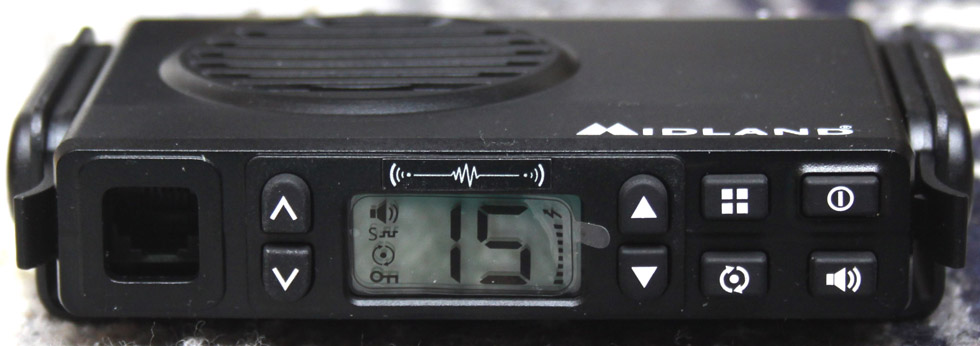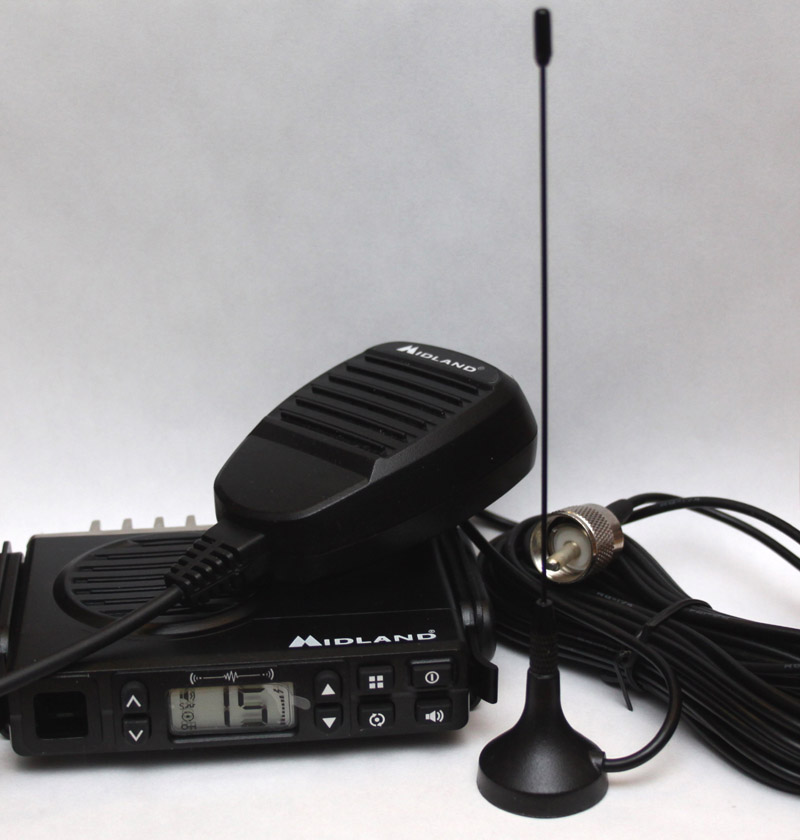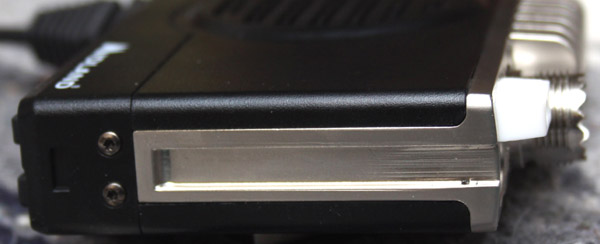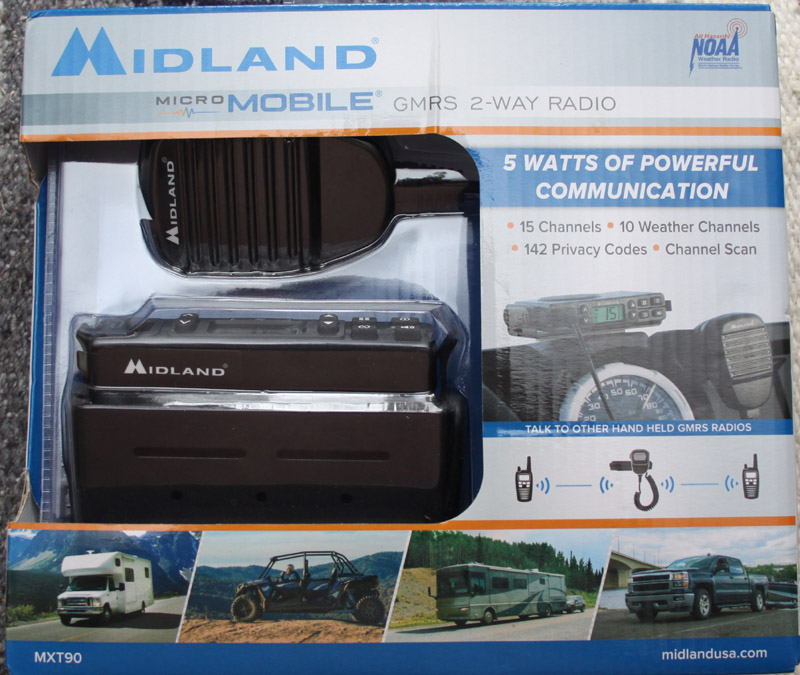|
Midland MTX90
FM GMRS transceiver
|
|

| Manual | GMRS | Operation | Repeaters |
| Antenna System | Factory Specifications | Frequencies | Links |
GMRS is a channelized radio service, operating in the UHF
band, around the 70cm ham band. Though quite a capable and
useful service, it has  been badly
tainted by being intertwined with the much less capable
FRS service. Because of this, dedicated GMRS radios have
been rare, and generally somewhat expensive. This may all
change soon, due to some rule changes, with the charge
being led by Midland.
been badly
tainted by being intertwined with the much less capable
FRS service. Because of this, dedicated GMRS radios have
been rare, and generally somewhat expensive. This may all
change soon, due to some rule changes, with the charge
being led by Midland.
Already a very
visible presence in the small hand held GMRS/FRS radio
market, Midland has introduced a line of Pure GMRS mobile
radios, with features and performance that better suit the
long ignored GMRS market. These radios are small, well
made, reasonably priced, and easy to use. They are also
quite sophisticated compared to the little bubble pack FRS
radios that presently rule this band.
 The Midland MTX90 is a GMRS only radio that puts out five
watts, can be used with a repeater, and includes the tones
that most repeaters require.
The Midland MTX90 is a GMRS only radio that puts out five
watts, can be used with a repeater, and includes the tones
that most repeaters require.
Being
a GMRS only radio means that this unit has a total
of fifteen channels, rather than the 22 channels of the
"hybrid" units. In the case of GMRS, less is more, because
eliminating the FRS channels removes the restrictions
placed upon FRS.
This allows the
unit to legally put out more power, have an external
antenna, and access repeaters. It also means somewhat
better build quality, and the requirement to get a license
to operate.
This unit is incredibly small. A look at the photos shows
that it is hardly larger than the microphone it uses. In
addition to the GMRS frequencies, seven weather band
channels are included - receive only, of course.
The radio is packed with an antenna, a standard
microphone, a microphone holder, a power accessory cord
(once known as a cigarette lighter adapter), a mounting
bracket, and a tiny instruction manual. Basically, this is
everything you need to get on the air, though you may want
a better antenna.
The small size,
quick insert power plug, and magnet mount antenna
encourage fast temporary installs. Really, installing this
radio in a vehicle  takes all of thirty seconds.
Removal is just as easy. For those who are reminded of the
old CB radios, there are some similarities, but GMRS has a
distinct identity of its own. More permanent mounting
solutions are easily available.
takes all of thirty seconds.
Removal is just as easy. For those who are reminded of the
old CB radios, there are some similarities, but GMRS has a
distinct identity of its own. More permanent mounting
solutions are easily available.
The side of the unit is fitted with rail mounts, and
mounting rails are included. A bracket is also included in
the package. This is a special production run radio for
Wal-Mart, and is the same model as the Midland branded
MTX105. Similar models with more power, the MTX115 with
fifteen watts, and the MTX400 with forty watts are also
made. I picked this radio up for around $50 when a local
store was clearing them out. Regular cost is just under
$90.
GMRS
GMRS is a
channelized radio service, operating in the UHF band,
around the 70cm ham band. Unlike FRS or CB, this is a
licensed service. A  GMRS license
lasts for ten years, and costs $70. It can be used by the
license holder and members of the immediate family. Unlike
CB, the FCC actively enforces regulations and licensing
requirements on GMRS. There is no test or knowledge
requirement to become licensed. You pay your fee, and the
FCC sends you your license and call sign.
GMRS license
lasts for ten years, and costs $70. It can be used by the
license holder and members of the immediate family. Unlike
CB, the FCC actively enforces regulations and licensing
requirements on GMRS. There is no test or knowledge
requirement to become licensed. You pay your fee, and the
FCC sends you your license and call sign.
UHF is not capable of the long rage skip that is a feature
of CB radio. It is very strictly limited to line of sight.
Depending upon terrain, this could be as much as 20 - 30
miles; but don't count on it. Expected range for a pair of
vehicle mounted radios is probably more like 3 - 5 miles.
Terrain has a huge effect though, and in hills, or around
large buildings, range can be cut by half or more.
The antenna for
this service is tiny, usually around six inches long. The
radio itself is also very small. .
The Bad
The band is not used in many countries.
There is a limited assortment of quality gear available.
A $70 fee is kind of
expensive, particularly when CB is free, and HAM is only
$15.
The Good
It has most of the characteristics of 2 meter, but uses antennas less than half the size. It does not scatter to the extent of 440.
If you get yourself a base or repeater, a mobile and a few handhelds, you can have a whole band to yourself in many areas.
So why bother?
That's a question I
can't answer. In my own case, I do it because I am a radio
enthusiast, and because I have young nieces and a a
nephew, that I may wish to talk to on camping trips,
vacations, etc. There are large numbers of casual radio
users out there, even in these cell phone saturated days.
|
Channel
#
|
Assignment
|
||
|
462.5625
|
1
|
Simplex
|
GMRS 5 watts OK
|
|
462.5875
|
2
|
Simplex
|
GMRS 5 watts OK
|
|
462.6125
|
3
|
Simplex
|
GMRS 5 watts OK
|
|
462.6375
|
4
|
Simplex
|
GMRS 5 watts OK
|
|
462.6625
|
5
|
Simplex
|
GMRS 5 watts OK
|
|
462.6875
|
6
|
Simplex
|
GMRS 5 watts OK
|
|
462.7125
|
7
|
Simplex
|
GMRS 5 watts OK
|
|
467.5625
|
8
|
Simplex
|
GMRS Not Allowed
|
|
467.5875
|
9
|
Simplex
|
GMRS Not Allowed
|
|
467.6125
|
10
|
Simplex
|
GMRS Not Allowed
|
|
467.6375
|
11
|
Simplex
|
GMRS Not Allowed
|
|
467.6625
|
12
|
Simplex
|
GMRS Not Allowed
|
|
467.6875
|
13
|
Simplex
|
GMRS Not Allowed
|
|
467.7125
|
14
|
Simplex
|
GMRS Not Allowed
|
Operation
Basic
operation is pretty simple. The GMRS service is not
designed for hobbyists, experimenters, or radio experts.
All controls are push button, including channel selectors.
The only places where the manual may have to be consulted
is for initial programming of tones for local repeaters,
if required. The radio also features privacy codes, which
can be handy. Basically, they filter out any signals not
accompanied by the set privacy code. These really does not
offer privacy, in the sens that it does nto prevent others
from listening in, but it does filter out any other users
fo a particular channel, and gives the illusion of having
that channel to yourself.
So how
much range can you really expect from such a radio? Much
depends upon who you are talking to, and what antenna you
decide to use. Presuming the radio uses the included
antenna mounted on a car roof, and is communicating with
another radio similarly configured, probably 3 - 5 miles.
Better antennas mounted at higher elevations give better
performance. So what about those advertisements that
promise a range of 25 - 40 miles? For this, you need a
repeater.
A repeater capable radio, operates in duplex mode, rather
than simplex mode. What this means is that it transmits on
one frequency,and receives on another. The repeater itself
also operates in duplex mode, but differs from the regular
radio operating in duplex, in that it transmits and
rebroadcasts at the same time. Repeaters use the opposite
frequencies of those used by the radios they serve. What
this means is that the repeater will receive on the
transmit frequency of the radios it serves, and transmit
on the on the receive frequencies. So radios using a
repeater will not be able to hear each other directly,
since they transmit on a frequency different than the one
on which they receive. Only through the re-transmissions
of the repeater can they hear each other.
Repeaters have
been in common commercial and public service use for
decades, and are also quite familiar to ham radio
operators, but may be new to the casual operator. Repeater
use is the secret to getting good range from these radios.
As it comes out of the box, with the included antenna,
this radio has a likely range of 3 - 5 miles. With a
better mobile antenna, this can go up to 5 - 7 miles.
Terrain will have an effect on range, as well as the
nature of the radio with which you are communicating, but
the numbers are close enough.
To get really good
range, you need to use a repeater. A repeater is a base
station, transmitting at full power (50 watts, in the case
of GMRS), with a very good antenna placed at a high
elevation. A repeater will get you that 25 - 35 mile
range that the sales brochures are always bragging about.
The reason they are able to do this is because they are
stationary, and their permanent installation allows for
exceptionally good antennas, mounted on towers or other
high structures, and for transmitters that operate on the
full 50 watts allowed by the service.
Repeaters have
been in use by government agencies for decades, and by ham
radio operators for almost as long. While it is possible
to find an 'open' repeater, which simply re-transmits
anything transmitted on its received frequency, most are
closed, and require simultaneous transmission of a
sub-audable tone, in order to operate. The prospective
repeater user must determine the tone frequency used for
the repeater, and then set it on his radio. There is a
decoder in the repeater that listens for this tone, and
will only re-transmit when it hears the appropriate tone.
Tones are used,
not so much to restrict access, but to prevent a repeater
from randomly re-transmitting static. Most repeaters list
the required tones, either on their websites, or on
repeater guides. Some ask for donations, but most are free
to use. Many ham operators have become GMRS users due to
the similarity fo repeater use, and so that they can share
portions of the radio hobby with unlicensed users.
Antenna System
One of the big
advantages of GMRS over FRS, is the allowance of external
antennas. A good antenna can make more of a difference in
performance than doubling, tripling, or even quadrupling
power. In FRS, an external antenna is strictly prohibited,
and all type approved radios will have very small, no gain
antennas, permanently attached. With a plethora of 70 cm
ham radio gear out there, a really good antenna should be
no problem.
Unfortunately,
one of the great disappointments of this radio is the
included antenna. It is a bare bones magnetic unit which
is adequate, but could be so much better. The radiator of
this little antenna is about 6" long. This makes it a
quarter wave at these frequencies, and uses the car body
as a ground.
Full 5W Radio + External Magnetic Mount Antenna for extended range
15 High and Low Power (GMRS) Channels *FCC License Required
142 Privacy Codes to block other conversations
Channel Scan (to monitor radio activity) with Controlled Frequency Synthesizer
High-Grade Microphone
Silent Operation when beeps/tones are not desired
Product Size (H x W x D): 0.75 x 4 x 3.25 in. Product Weight (lb): 1.03 ozLinks
| WRBN710 |
FCC
GMRS Page |
MyGMRS |
|
| Midland
GMRS |
Get
Your License |